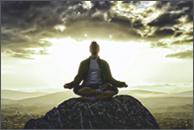 Autumn marks the transition to longer hours of darkness. While many of us welcome the beauty and cooling temperatures of the season, many start to anticipate, with some anxiety and dread, cold, snow, and barren landscapes.
Autumn marks the transition to longer hours of darkness. While many of us welcome the beauty and cooling temperatures of the season, many start to anticipate, with some anxiety and dread, cold, snow, and barren landscapes.
Yoga teachings tell us that “everything changes” – everything that is part of the material world – seasons, weather, the phases of the moon, the habits of animals, friends, our bodies. Even though we recognize this, we often greet change with resistance, especially if we like things the way they are. Let’s face it. If cold weather means our joints ache or the increased hours of darkness leave us depressed, embracing the seasonal changes marking winter’s approach is difficult. Yet, hanging on to the way things are in the face of change inevitably causes anxiety and pain, as we no longer live in the moment but in anticipation of what suffering may come.
Yoga also teaches that while change comes, a place within each one us exists that is unchanging, eternal, and it is called purusa. We can think of purusa as our inner light. When we are able to recognize and identify with purusa as that which is truly who we are, our perception clears and our decisions tend to have positive results. We can experience peace and joy in the face of our ever-changing life and circumstances.
For most of us, however, life fills with tasks, 24/7 news, on-line social connections and activities, advertising telling us what we need and how to live. All of this can fill our minds and engage our emotions in not so pleasant or helpful ways. The concept vrttis in the Yoga Sutra refers to the activity and fluctuations of our mind and our emotions. When the mind fluctuates from the ever-growing “to do” list, to worries about our children, life situation or what is happening on the other side of the world, vrttis with negative effects dominate. We feel overwhelmed, confused, or out of balance. Decisions we make when in that state may be based on faulty understanding and lead to painful consequences.
When the activity of the vrttis so mires the mind, our identity is not with purusa, but rather with what constantly changes around us. A veil covers our inner light.
So how can we deal these negative vrttis in our lives as the realities of our lives involve taking care of ourselves, caring for others, working, being informed, suffering losses, participating in the society in which we live?
“Accentuate the positive” is a simplistic yet realistic and yogic answer. Yoga is not just stretching our limbs. Yoga seeks to move the activity of mind/emotions – the vrttis – in a positive direction. Suppose, for example, we decide to consciously practice the recommended ethical practices of the yamas – compassion, truthfulness, moderation, not stealing, non-hoarding. Living in an ethical and conscious way connects us to positive thoughts and values and causes the negative vrttis to diminish as the positive grows.
The Yoga Sutra offers wisdom to help us better understand ourselves and live with greater awareness, harmony, and joy. I invite you to return to the Yoga 4 Healthful Living Blog as we continue to explore these teachings and relate them to our lives.
 Brahmacharya is the 4th of the five yamas or attitudes and behaviors the Yoga Sutra recommends for our dealings with others.
Brahmacharya is the 4th of the five yamas or attitudes and behaviors the Yoga Sutra recommends for our dealings with others.